- 易迪拓培训,专注于微波、射频、天线设计工程师的培养
《SAR 型与高速 ΔΣ 型 ADC 的选择》(英)
So which device do you choose for your application circuit? To make that determination, you need to compare the operation of these two devices. A/D-conversion latency is the time the ADC takes to go from one sample to the next, including the data-retrieval time. SAR-converter latency comprises a "snapshot" of the signal and the serial retrieval of the data. In contrast, the delta-sigma ADC has a larger output-code delay because the converted signal does not correspond to a single point in time. The delta-sigma converter quickly averages the input for a predetermined time before outputting the digital code at higher speeds (Figure 1). The trade-off between the converters is that the delta-sigma ADC consumes more power due to higher clock rates.
A common disappointment when you use a SAR converter is the presence of large variance in the output code for a dc input signal. The problem often is not the converter, but how you implement the application circuit. A SAR converter has a wide input bandwidth and fast reaction to signal changes. The one-time-sample-per-conversion architecture effectively captures the signal and its noise. This type of converter in a noisy environment requires a high-order, antialiasing filter. The addition of an antialiasing filter solves the noise problem but increases the settling time of the converter system. The system settling time is an issue in multiplexed-system applications.
In contrast, a delta-sigma converter averages multiple samples at a higher data rate for each conversion result. The digital filter in these converters acts as an antialiasing filter, so that the converters need only an external second-order lowpass filter on the analog input. A delta-sigma converter easily handles signal noise with its internal digital-filtering system. However, if you present a step input to the delta-sigma-converter input, the converter also requires time to settle. The on-chip digital filter requires time to refill and resettle.
Both types of converters offer other benefits. SAR converters can have embedded multiplexers or PGAs (programmable-gain amplifiers) at their inputs. Some delta-sigma converters have multiplexers and PGAs, but they may also have input buffers, sensor-burnout current sources, and higher order systems than do SAR converters. On the application level, how do you differentiate between these converters? SAR converters suit applications that require fast response and low latency, such as high-speed control loops and multichannel data-acquisition systems. Delta-sigma converters target applications that require high resolution, such as scales or audio systems. However, both types of converters find use in motor control, sonar, and vibration analysis, which require precision, wide bandwidth, and high-resolution operation.

